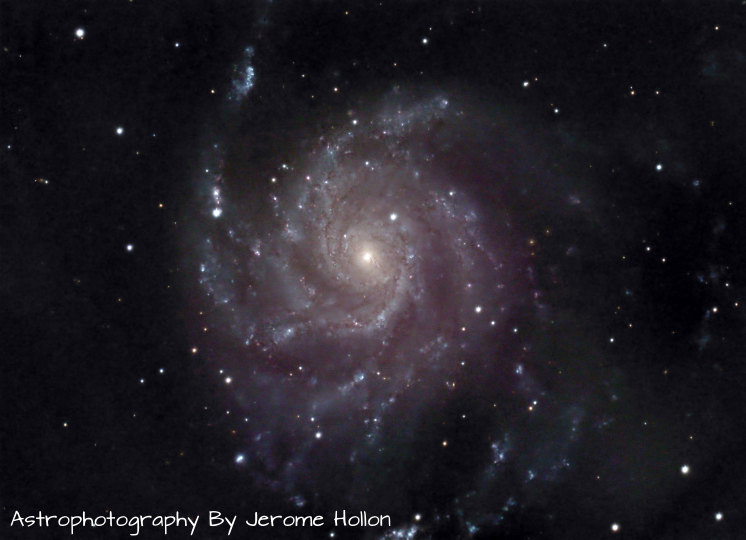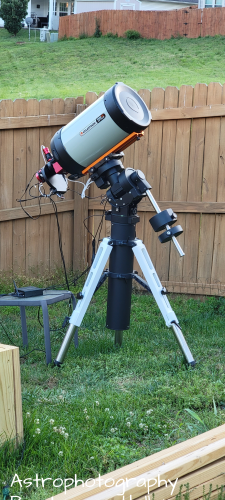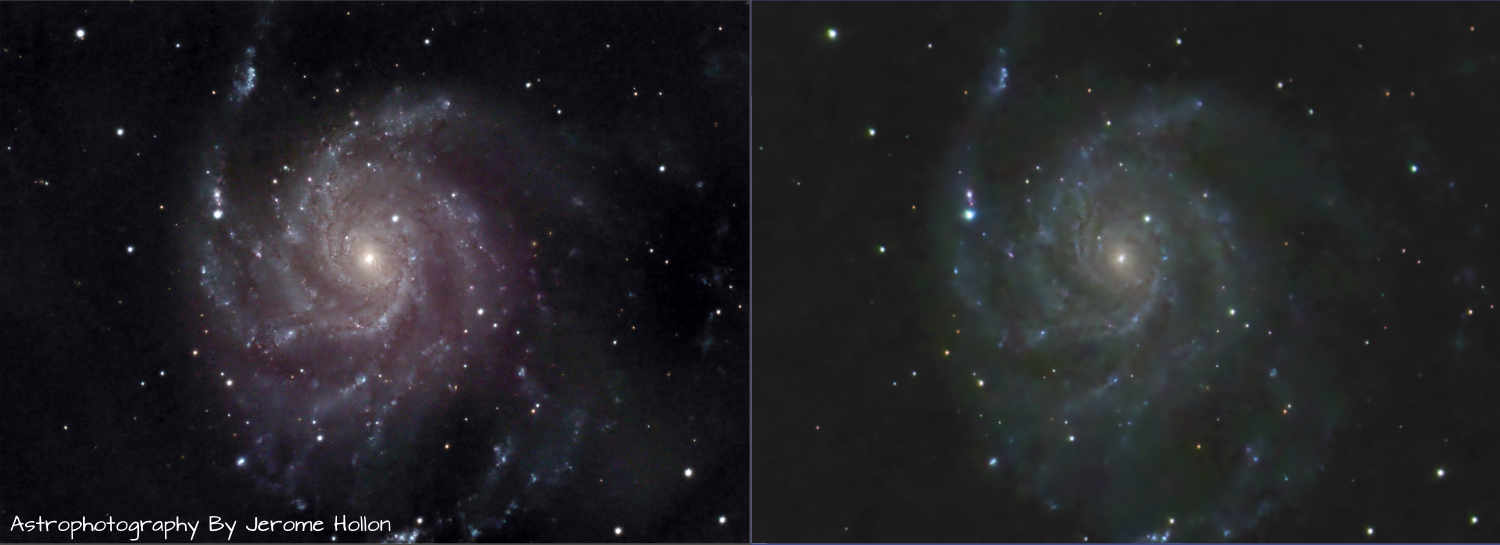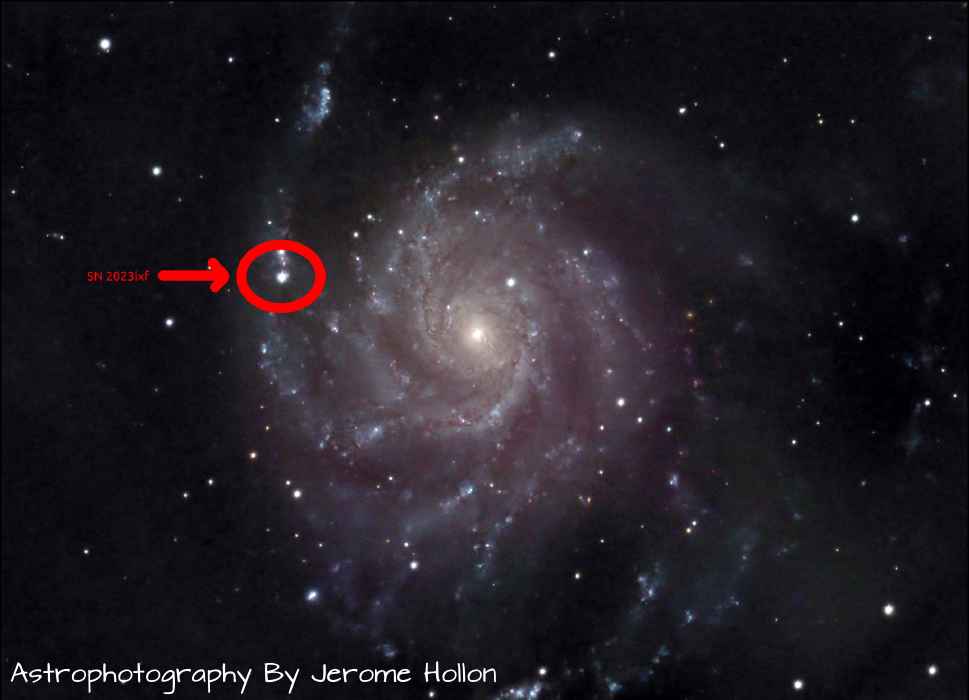Pinwheel Galaxy With Supernova
Jun 17, 2023
Pinwheel Galaxy with Supernova
| Other names | M101, NGC 5457, UGC 8981 |
| Type | Galaxy |
| Distance | 21,000,000 ly |
| Size | 170,000 ly |
| Location | Ursa Major |
| Captured | Jun 17, 2023 |
| Capture type | Broadband |
| Total time | 6 hours |
| Frames | LRGB 24x300' each |
| Telescope | Celestron EdgeHD 11 |
| Camera | ZWO ASI294mm |
| Tripod | CGEM-70-EC |
Pinwheel Galaxy with Supernova 2023ixf
I’m posting this image a little bit out of chronological order, but only because I’m super excited about it. It’s the first image from my new telescope, my partner bought me a Celestron EdgeHD 11 out of the blue because I was super excited about observing the supernova. I don’t know what I did to deserve him, but fellas, if your fella doesn’t buy you a telescope out of the blue, find another one that really loves you! Bet you didn’t expect bad relationship advice in my blog!
The new telescope is a Cassegrain telescope, meaning that it bounces the light around internally twice. This leads to a really long focal length from a physically shorter telescope. My telescope, while only 610mm in length, has a focal length of 2800mm. The drawback is a Cassegrain has a central obstruction that can reduce the contrast a bit, but the larger aperture of the telescope, the less that matters. Cassegrains are complex to manufacture because they require two spherical ground mirrors to align everything. This adds to their cost, but if done right it gives you a really high-performance device in a small package. Most of our space telescopes, like the Hubble and the JWST, are both Cassegrain telescopes.
What is Focal Length Anyway?
Aperture is and always will be king for astrophotography. The wider the telescope’s mirrors the more light it can gather more quickly. So why all this talk about focal length? The focal length determines, forgive me for the moment, the magnification of the object being observed. Magnification is really the wrong term, the more correct term is pixel scale, or the number of pixels per arcsecond. I can take a short focal length, photograph the same object, and then crop the image to be the same size as the image in my longer focal length camera. They’ll both have the same “magnification” but the one with the longer focal length will have more detail. For example, in a shorter focal length telescope, a swirl or band of gas might only be 2-3 pixels wide, but in the longer focal length shot, it could be 15-20 pixels, allowing much greater detail and sharpness.
I also captured M101 with my old 610mm newtonian telescope, and then fit their alignment, rotation and image scales. This makes them take up the same amount of screen space, but you can clearly see how much more detail you’re able to make out on the 2800mm telescope.
Galaxy Hunting
For galaxy hunting and planetary photography, these longer focal length telescopes are much preferred because you can get much more detail from a very small object. I’m excited to collect more galaxies this summer with the new telescope. Summer is considered galaxy season, at least in the northern hemisphere, because at night earth is facing away from the galactic core. That means fewer nebulas and dust to see through when trying to image galaxies. Something that most people don’t realize, every nebula we can see and image is in our own galaxy. We can’t see nebulas in other galaxies, at least with our current technology. Similarly, unless the star appears inside a galaxy, we’re actually seeing only the stars in our own galaxy. So in this photo, the stars, outside what you see in the arms, are all in our own galaxy.
Supernova 2023ixf
So after a lot of rambling, I’m finally getting to why I said “with Supernova 2023ixf” in the title. SN 2023ixf went supernova on May 19th and is currently in plateau. We don’t know when it will start to fade, probably in a few months. I got a couple of shots as it was brightening up, but wasn’t able to get enough detail to make a gif of it brightening. Maybe I’ll figure out how to do that someday, but that’s beyond my abilities so far.
SN 2023ixf is one of the brightest and closest supernovae we’ve witnessed in recent history. I believe it is expected to reach a magnitude of around 10, meaning with dark skies and a small pair of binoculars you could see it yourself. But it will not be visible to the naked eye even under the darkest skies. The star that led to this supernova’s progenitor star was between 8 and 50 times the mass of our star, which produces a type II supernova. We’re not sure yet what type of type II supernova it is. Consensus is leaning toward a Type II-L from spectral analysis. ‘L’ just means that it will have a linear decline in brightness as it begins to fade. But it could still be a Type II-P. Type II-P has a long plateau (the P in II-P) with a sudden drop in brightness at the of its life.
What comes after? We’re not sure yet, but the odds favor it becoming a neutron star. It could also form a black hole, but that is less likely. Time will tell for sure, but probably not for another couple of months. It does not have a companion star to siphon material from, so this is likely a one-and-done event for this star. Exciting to witness!




